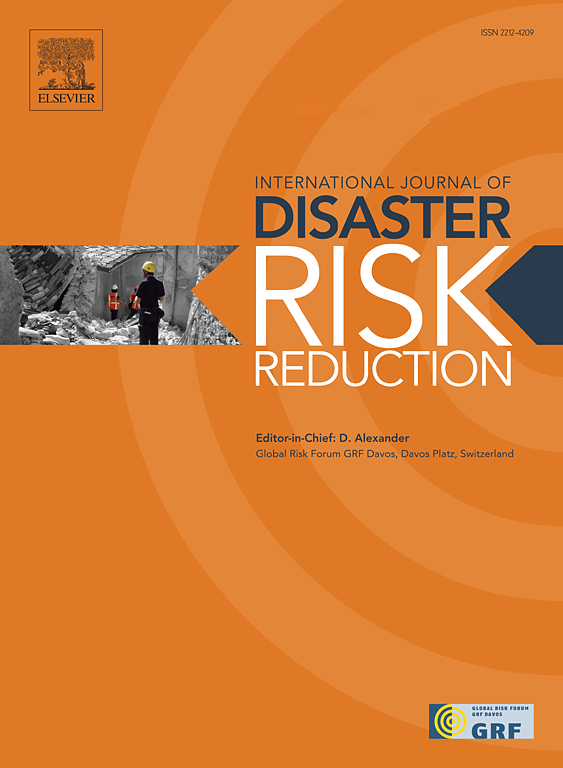Seismic spatiotemporal assessment of indoor occupant casualties in regional buildings: A Bayesian network approach incorporating population density dynamics
IF 4.2
1区 地球科学
Q1 GEOSCIENCES, MULTIDISCIPLINARY
International journal of disaster risk reduction
Pub Date : 2025-06-07
DOI:10.1016/j.ijdrr.2025.105637
引用次数: 0
Abstract
In the context of rapid population growth and accelerated urbanization, the impact of earthquake disasters has intensified, making human casualties a critical concern. Accurate prediction of earthquake-induced casualties is essential for developing emergency response strategies, optimizing rescue resource allocation, and facilitating post-earthquake decision-making. This study employs a Bayesian Networks (BNs) model to systematically integrate information on both structural and non-structural components, as well as social factors, to construct a multifactorial assessment framework. This framework accurately estimates the probability of indoor occupants' life safety status during an earthquake. It considers the effect of population density, escape capability and rescue efficiency on individual safety and develops life safety status fragility surface with ground motion intensity measures and population density. Monte Carlo simulation is utilized to enable real-time prediction of indoor occupant life safety status within a single building structure. The study further extends to regional scale by incorporating the spatial correlation of ground motion intensity measures. This innovation facilitates a dynamic, spatiotemporal assessment of life safety status within a regional building portfolio. The findings highlight the critical role of ground motion intensity measures and population density in assessing indoor occupant casualties. By dynamically monitoring population distribution and real-time updating of ground motion intensity measures, the assessment framework proposed in this study can effectively enhance the accuracy and efficiency of earthquake disaster emergency response, providing a reliable scientific basis for government departments to facilitate rapid rescue operations and optimize resource allocation in the aftermath of an earthquake.
区域建筑室内人员伤亡的地震时空评估:结合人口密度动态的贝叶斯网络方法
在人口快速增长和城市化加速的背景下,地震灾害的影响加剧,使人员伤亡成为一个严重问题。准确预测地震伤亡对制定应急响应策略、优化救援资源配置、促进灾后决策至关重要。本研究采用贝叶斯网络(BNs)模型,系统整合结构成分和非结构成分以及社会因素的信息,构建多因素评估框架。该框架准确地估计了地震时室内居住者生命安全状态的概率。考虑了人口密度、逃生能力和救援效率对个体安全的影响,结合地震动强度指标和人口密度,建立了生命安全状态脆弱性面。利用蒙特卡罗模拟实现了对单个建筑结构内室内居住者生命安全状态的实时预测。通过结合地震动强度测量的空间相关性,进一步将研究扩展到区域尺度。这一创新有助于对区域建筑组合中的生命安全状态进行动态、时空评估。研究结果强调了地面运动强度测量和人口密度在评估室内人员伤亡方面的关键作用。通过动态监测人口分布和实时更新地震动烈度指标,本研究提出的评估框架可有效提高地震灾害应急响应的准确性和效率,为政府部门在震后快速开展救援行动和优化资源配置提供可靠的科学依据。
本文章由计算机程序翻译,如有差异,请以英文原文为准。
求助全文
约1分钟内获得全文
求助全文
来源期刊

International journal of disaster risk reduction
GEOSCIENCES, MULTIDISCIPLINARYMETEOROLOGY-METEOROLOGY & ATMOSPHERIC SCIENCES
CiteScore
8.70
自引率
18.00%
发文量
688
审稿时长
79 days
期刊介绍:
The International Journal of Disaster Risk Reduction (IJDRR) is the journal for researchers, policymakers and practitioners across diverse disciplines: earth sciences and their implications; environmental sciences; engineering; urban studies; geography; and the social sciences. IJDRR publishes fundamental and applied research, critical reviews, policy papers and case studies with a particular focus on multi-disciplinary research that aims to reduce the impact of natural, technological, social and intentional disasters. IJDRR stimulates exchange of ideas and knowledge transfer on disaster research, mitigation, adaptation, prevention and risk reduction at all geographical scales: local, national and international.
Key topics:-
-multifaceted disaster and cascading disasters
-the development of disaster risk reduction strategies and techniques
-discussion and development of effective warning and educational systems for risk management at all levels
-disasters associated with climate change
-vulnerability analysis and vulnerability trends
-emerging risks
-resilience against disasters.
The journal particularly encourages papers that approach risk from a multi-disciplinary perspective.
 求助内容:
求助内容: 应助结果提醒方式:
应助结果提醒方式:


